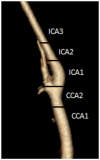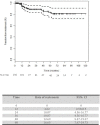Anatomical and Technical Factors Influence the Rate of In-Stent Restenosis following Carotid Artery Stenting for the Treatment of Post-Carotid Endarterectomy Stenosis
- PMID: 27611997
- PMCID: PMC5017627
- DOI: 10.1371/journal.pone.0161716
Anatomical and Technical Factors Influence the Rate of In-Stent Restenosis following Carotid Artery Stenting for the Treatment of Post-Carotid Endarterectomy Stenosis
Abstract
Background: Carotid artery stenting (CAS) has been advocated as an alternative to redo surgery for the treatment of post-carotid endarterectomy (CEA) stenosis. This study analyzed the efficacy of CAS for post-CEA restenosis, focusing on an analysis of technical and anatomical predictive factors for in-stent restenosis.
Methods: We performed a retrospective monocentric study. We included all patients who underwent CAS for post-CEA restenosis at our institution from July 1997 to November 2013. The primary endpoints were the technical success, the presence of in-stent restenosis >50% or occlusion, either symptomatic or asymptomatic, during the follow-up period, and risk factors for restenosis. The secondary endpoints were early and late morbidity and mortality (TIA, stroke, myocardial infarction, or death).
Results: A total of 153 CAS procedures were performed for post-CEA restenosis, primarily because of asymptomatic lesions (137/153). The technical success rate was 98%. The 30-day perioperative stroke and death rate was 2.6% (two TIAs and two minor strokes), and rates of 2.2% (3/137) and 6.2% (1/16) were recorded for asymptomatic and symptomatic patients, respectively. The average follow-up time was 36 months (range, 6-171 months). In-stent restenosis or occlusion was observed in 16 patients (10.6%). Symptomatic restenosis was observed in only one patient. We found that young age (P = 0.002), stenosis > 85% (P = 0.018), and a lack of stent coverage of the common carotid artery (P = 0.006) were independent predictors of in-stent restenosis.
Conclusion: We identified new risk factors for in-stent restenosis that were specific to this population, and we propose a technical approach that may reduce this risk.
Conflict of interest statement
The authors have declared that no competing interests exist.
Figures




Similar articles
-
Primary carotid artery stenting versus carotid artery stenting for postcarotid endarterectomy stenosis.J Vasc Surg. 2009 Nov;50(5):1031-9. doi: 10.1016/j.jvs.2009.06.051. Epub 2009 Aug 22. J Vasc Surg. 2009. PMID: 19703753
-
A Propensity Matched Comparison for Open and Endovascular Treatment of Post-carotid Endarterectomy Restenosis.Eur J Vasc Endovasc Surg. 2018 Feb;55(2):153-161. doi: 10.1016/j.ejvs.2017.11.015. Epub 2017 Dec 26. Eur J Vasc Endovasc Surg. 2018. PMID: 29288058
-
Carotid artery stenting outcomes are equivalent to carotid endarterectomy outcomes for patients with post-carotid endarterectomy stenosis.J Vasc Surg. 2010 Nov;52(5):1180-7. doi: 10.1016/j.jvs.2010.06.074. Epub 2010 Aug 8. J Vasc Surg. 2010. PMID: 20692794
-
A meta-analysis of combined endarterectomy and proximal balloon angioplasty for tandem disease of the arch vessels and carotid bifurcation.J Vasc Surg. 2011 Aug;54(2):534-40. doi: 10.1016/j.jvs.2011.04.022. J Vasc Surg. 2011. PMID: 21684709 Review.
-
Ultrasound surveillance after CAS and CEA: what's the evidence?J Cardiovasc Surg (Torino). 2014 Apr;55(2 Suppl 1):33-41. J Cardiovasc Surg (Torino). 2014. PMID: 24796896 Review.
Cited by
-
Recurrent stenosis following carotid artery stenting treated with a drug-eluting balloon: a single-center retrospective analysis.Neuroradiology. 2018 Jan;60(1):81-87. doi: 10.1007/s00234-017-1935-7. Epub 2017 Oct 20. Neuroradiology. 2018. PMID: 29058047
-
The management of carotid restenosis: a comprehensive review.Ann Transl Med. 2020 Oct;8(19):1272. doi: 10.21037/atm-20-963. Ann Transl Med. 2020. PMID: 33178804 Free PMC article. Review.
-
Short- and Mid-Term Outcomes of Stenting in Patients with Isolated Distal Internal Carotid Artery Stenosis or Post-Surgical Restenosis.J Clin Med. 2022 Sep 24;11(19):5640. doi: 10.3390/jcm11195640. J Clin Med. 2022. PMID: 36233508 Free PMC article.
-
Severe, recurrent in-stent carotid restenosis: endovascular approach, risk factors. Results from a prospective academic registry of 2637 consecutive carotid artery stenting procedures (TARGET-CAS).Postepy Kardiol Interwencyjnej. 2019;15(4):465-471. doi: 10.5114/aic.2019.90221. Epub 2019 Dec 8. Postepy Kardiol Interwencyjnej. 2019. PMID: 31933663 Free PMC article.
-
Calcification patterns in femoral and carotid atheromatous plaques: A comparative morphometric study.Exp Ther Med. 2021 Aug;22(2):865. doi: 10.3892/etm.2021.10297. Epub 2021 Jun 11. Exp Ther Med. 2021. PMID: 34178138 Free PMC article.
References
-
- Lattimer CR, Burnand KG. Recurrent carotid stenosis after carotid endarterectomy. Br J Surg. 1997;84(9):1206–19. . - PubMed
-
- AbuRahma AF, Abu-Halimah S, Hass SM, Nanjundappa A, Stone PA, Mousa A, et al. Carotid artery stenting outcomes are equivalent to carotid endarterectomy outcomes for patients with post-carotid endarterectomy stenosis. Journal of vascular surgery. 2010;52(5):1180–7. 10.1016/j.jvs.2010.06.074 . - DOI - PubMed
MeSH terms
LinkOut - more resources
Full Text Sources
Other Literature Sources

